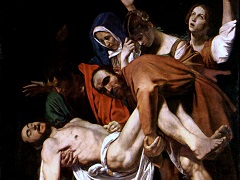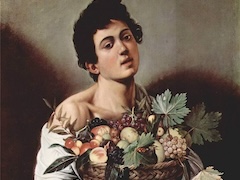The Crucifixion of Saint Peter, 1601 by Caravaggio

Saint Peter, already nailed to the half-raised cross, provides the focus of the composition. Following the tradition that he chose to be crucified upside down so as not to rival Christ, the cross is being elevated with his feet above his head. This position permits him to turn his head to look out of the picture, not toward the worshiper, as in Michelangelo's Pauline Chapel fresco, but toward the crucifix on the chapel altar, as a source of reassurance to him and as his testimony of faith. The emphasis of the picture is on this faith. There is no bloodshed or sense of pain ; the artist has eschewed sensa-tionalism for understated drama. The executioners - the one in the lower left corner derives from Jac-opo Bassano - are characterized as effcient anonymous mechanical forces, coarse but without the rancor of those in The Flagellation. The only one of their faces that is at all visible is hidden in shadow and is expressionless. Saint Peter is depicted as a husky old man, hardly worn by age, not panic-stricken as in his denial of Christ or in the Quo Vadis Domini? in the ceiling fresco overhead, but calm, stern, resolute, a rock of faith on which the Church could be founded and would be secure. His position of helplessness and his acceptance of his martyrdom contrast with the executioners straining at their task. But they are merely the apparent operative force, for they have significance only in relation to him, as the means through which he can witness Christ and go to the better life.
This message is conveyed with great economy of means. The mechanics of elevating the cross have been carefully calculated so as to be convincing. But the absence of spectators transmutes the crucifixion from an historical event to a personal ordeal. Presumably Caravaggio made use of his newly developed nocturnal light less as a stylistic mannerism than to emphasize this intimacy. The figures are set relief-like against the dark wall. They are ponderous, deliberate, and dignified; their monumental massiveness reinforces the import of the martyrdom.
















